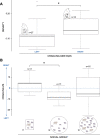Human-like maternal left-cradling bias in monkeys is altered by social pressure
- PMID: 32620801
- PMCID: PMC7335100
- DOI: 10.1038/s41598-020-68020-3
Human-like maternal left-cradling bias in monkeys is altered by social pressure
Abstract
About 66-72% of human mothers cradle their infants on their left side. Given that left-cradling exposes the baby's face to the mother's left visual field (i.e., mainly projected to her right hemisphere) and is altered by emotional states such as stress, maternal left-cradling was interpreted as reflecting right-hemispheric dominance for emotional processing. Whether this phenomenon is unique to human evolution is still in debate. In the present study we followed 44 olive baboon (Papio anubis) mothers and their infants in different social groups. We found that a maternal cradling bias exists and is predominantly towards the left in a similar proportion as in humans, but shifts toward a right bias in mothers living in high density groups. The sensitivity of left-cradling to social pressure highlights its potential links with the mother's stress as reported in humans. Our finding clearly illustrates the phylogenetic continuity between humans and Old-World monkeys concerning this lateralization and its potential links with hemispheric specialization for emotions, inherited from a common ancestor 25-35 million years ago.
Conflict of interest statement
The authors declare no competing interests.
Figures



References
-
- Packheiser J, Schmitz J, Berretz G, Papadatou-Pastou M, Ocklenburg S. Handedness and sex effects on lateral biases in human cradling: three meta-analyses. Neurosci. Biobehav. Rev. 2019;104:30–42. - PubMed
-
- Todd BK, Banerjee R. Lateralization of infant holding by mothers: a longitudinal evaluation of variations over the first 12 weeks. Laterality. 2015;21:12–33. - PubMed
-
- Almerigi JB, Carbary TJ, Harris LJ. Most adults show opposite-side biases in the imagined holding of infants and objects. Brain Cogn. 2002;48:258–263. - PubMed
-
- Forrester GS, Davis R, Mareschal D, Malatesta G, Todd BK. The left cradling bias: an evolutionary facilitator of social cognition? Cortex. 2019;118:116–131. - PubMed

